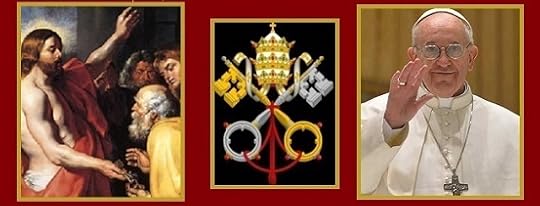Carl E. Olson's Blog, page 111
February 5, 2014
The Papacy: The Person Versus The Office
The Papacy: The Person Versus The Office | Fr. David Vincent Meconi, SJ | HPR
What draws the secular media to the Vatican … (for now) is the man who is able to translate these truths into action, and to proclaim our doctrine with personal conviction.
It is one of those few moments forever emblazoned on my mind. It was in the early 90s when five of us young Jesuit novices went to the Gesù Church in Detroit to profess solemn vows. The Father Provincial preached that hot Saturday afternoon. As he was addressing the congregation from the raised pulpit, a side door, directly underneath him, surprisingly and swiftly opened. A little girl, face beaming with total joy and delight, fell to the floor instantly as she met the turned heads and stares of a few hundred strangers. Behind the door she had just opened, stood someone—presumably her mother—with bucket and mop in hand—as we were obviously intruding upon this family’s Saturday work of coming to clean the church for Sunday Mass.
Yet, without missing a beat, my Provincial smiled, and leaned down to her while gently gesturing her to come closer, saying, “Come in, Sweetie! You’re the only reason we do all of this!” At that moment, I fell a bit more in love with the Jesuits. Here was my Superior, a man respected for his gravitas, instinctually showing us that our liturgy, and our very lives, were for the sake of God’s people. We were not there to be congratulated for our vows; we were there to vow our lives for service to others. The liturgy was not there to bring us out of this world, but to unite all of us in the one true sacrifice of Christ.
What I witnessed at that moment, unrehearsed, captured well what today’s best known Jesuit seems to be teaching the entire world. Pope Francis is in love with God’s people. He is following Jesus, walking through the grain fields of propriety and ritual, knowing how to shuck what is superfluous, and savor what is substantial. Francis is not afraid to show us who he is as a man, and as a priest. Yet, at another level, he is about “more of the same,” without differing from any preceding pontiff. At the level of his own personal style, Francis feels free to formulate Christian doctrine as he sees fit. At the level of his role as universal teacher, he is holding tightly onto the foundations of the Faith.
Toward the end his epic, Paradise Lost, John Milton (d. 1674) depicts Adam and Eve’s first attempt at reconciliation since their rebellion against Goodness. After bickering, finger-pointing, and outright hatred, we finally hear Adam say to Eve that they should:
How Do We Advance Subsidiarity?

How Do We Advance Subsidiarity? | James Kalb | CWR
Like other aspects of Catholic social teaching, what subsidiarity requires most of all is that Catholics live as Catholics
Subsidiarity is integral to a social doctrine based on natural law rather than technology. That ought to be a feature rather than a bug, but in today’s world it means no one can make sense of it or apply it coherently.
The principle tells us that lower level associations such as families and local communities should carry on the greater part of the life of society, and higher level associations such as the state should facilitate their efforts. The point is to make social life more truly human, since face to face communities are more human than the stock market or the Code of Federal Regulations.
The approach is in line with social justice, understood in the Catholic manner as “conditions that allow associations or individuals to obtain what is their due, according to their nature and their vocation.” Lower level associations are due a setting that lets them pursue their vocation effectively, and subsidiarity calls on higher level associations to promote such a setting. It is also consistent with the Holy Father’s call in Evangelii Gaudium for “growth in justice [supported by] decisions, programmes, mechanisms and processes specifically geared to a better distribution of income, the creation of sources of employment and an integral promotion of the poor which goes beyond a simple welfare mentality.” The call is for measures that promote the growth of productive and rewarding connections between the poor and the rest of society, rather than direct delivery of material benefits (which would be “a simple welfare mentality”).
While the approach makes a great deal of sense, it is not always obvious how to apply it. Actions don’t come with labels saying whether they constitute direct state intervention or support for the functioning of individuals and local groups. Nor do general principles make it clear what specific situations are urgent enough to justify the temporary direct intervention in social and economic life for the sake of the common good that Bl. John Paul II mentions in Centesimus Annus. So it seems that subsidiarity is less an enforceable rule that can be applied by anyone regardless of his views on other subjects than a guiding principle for building a good social order that has to be applied prudently, keeping in mind the proper balance of goals and a deep understanding of human nature and the workings of the system.
Unfortunately, that kind of complex, steady, and statesmanlike approach is hard to find in politics today.
February 3, 2014
"Shelter for All": A Review of "Gimme Shelter"
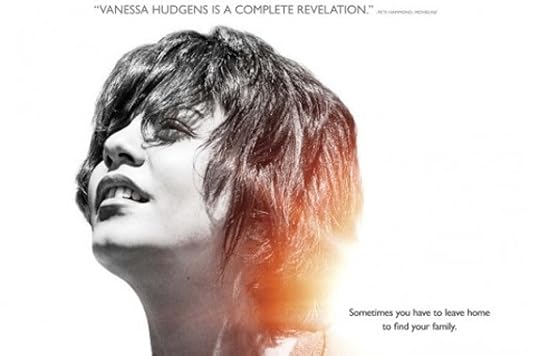
by Nick Olszyk for CWR
Gimme Shelter is beautifully written, features amazing performances, and has the real capacity to change lives
MPAA Rating, PG-13
USCCB Rating, A-III
Reel Rating: 


 (4 Reels out of 5)
(4 Reels out of 5)
Note: Spoilers Alert!
In the 1938 classic Boys Town, Fr. Flanagan famously said, “there is no such thing as a bad boy.” He didn’t mean males never sin; rather, the worst social situations and bad habits of the homeless rebel teenager do not remove his God-given dignity or opportunity for redemption. The same is true for Apple, a poor, expectant teenager who escapes her abusive mother in search of a home. Gimme Shelter is the best pro-life movie yet made, mostly because it is an actual movie rather than a two-hour sermon. It is beautifully written with amazing performances by A-list actors. Most importantly, it has the real capacity to change lives.
The film opens with Apple Bailey (Vanessa Hudgens) brutally cutting her hair and calling a cab to pick her up. It is unknown who this girl is, why she is changing her looks, or where she is going in such a hurry. Gradually, it becomes clear she is fleeing her monster of a mother, June (Rosario Dawson), and seeking her biological father, Tom (Brendan Frasier), with only a decade-old letter to guide her. Tom, now a successful stock broker, is open to helping her, but his wife Joanna is less keen, especially when it is revealed that Apple is pregnant from a brief affair (not unlike Tom and June). They arrange an abortion for Apple. Waiting at the clinic, Apple takes one last peek at the ultrasound picture and runs away weeping.
When Apple emerges from the clinic, she will not return to her father and becomes homeless. While fleeing a prospective pimp, she steals a car and promptly crashes. In the hospital, she meets Fr. McCarthy (James Earl Jones in an amazing performance). He gently tries to lead her soul to peace while guiding her to Catholic shelter for pregnant mothers in need run by a saintly woman named Kathy (Ann Dowd). The shelter provides Apple with her first genuine security in life including protection from June, spiritual guidance, financial assistance, and, most importantly, love. While initially hesitant, she eventually connects with the other woman at the shelter over their common struggles and finds a true home.
This film is a tremendously effective treatise on abortion because it connects the situation of Apple with that of her child. It handles abortion in a direct, realistic fashion without dramatic music, screaming, or political overtones.
The Lingering Trance of "Green Dolphin Street"
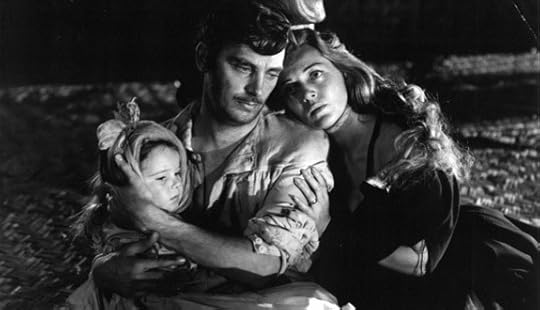
The Lingering Trance of Green Dolphin Street | Patrick Coffin | The Cinephile | CWR
"Our whole marriage has been a...slip of the pen?"
Some movies linger in your spirit for long stretches. They put you in a trance—disturbed, humorous, or charmed, depending. You re-watch them (let’s call them atmospheric films) and the trance returns thicker, and even more pleasant.
Green Dolphin Street (1947) belongs in this charming category. Directed by Victor Saville and based on the 1944 novel of the same name by English novelist Elizabeth Goudge, the movie has a haunting quality, a la Frank Capra’s dreamy epic Lost Horizon (1937).
Screenwriter Samuel Raphaelson condenses Goudge’s floral, unusually vivid descriptive style into a 161-minute adaptation that became MGM’s highest grossing film of 1947. Nominated for a handful of Academy Awards it took home the Special Effects statuette for the then state-of-the-art earthquake and tsunami scenes, which cost MGM $500,000—a whopping budget item at the time.
The movie-going public was primed for a change of pace from rah rah World War II dramas, rugged Westerns, and light Bing Crosby-Bob Hope comedies. The last successful “costume drama,” as they were called, was the gigantic hit Gone With the Wind (1939), and the studio brass were evidently convinced that it was an anomaly at the box office. By the end of the war, the poofy dress genre was ripe for a reboot. In acquiring the rights to the Goudge novel, they hit pay dirt.
Like all classic stories, Green Dolphin Street makes use of an epic backdrop (complete with glorious nineteenth-century sailing ships and an august cliff-top monastery) to tell a simple story of love found, betrayed—and regained, but in a in a way that brims with bittersweet irony.
It’s also a depiction of the dynamics behind the way some families seem to pass identical patterns of bad luck.
Summarizing the plot makes it inevitably sound like a cross between Downton Abbey and a Mexican TV novella.
January 31, 2014
15 Lies at the Basis of Our Culture
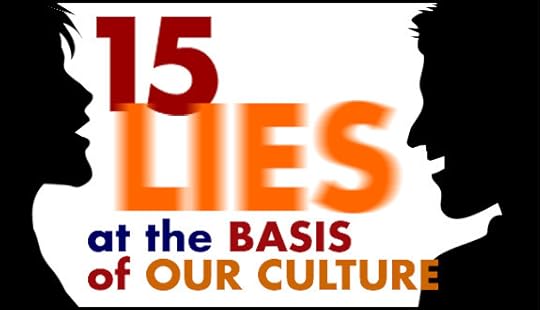
15 Lies at the Basis of Our Culture | Fr. James V. Schall, SJ | CWR
Each of these lies, on examination, denies or violates a principle of reason or a fact of science
A culture is a complex composition of the manners, rites, language, laws, ideas, and customs of a people. These sources describe what a given people hold to be true, or at least valid. How they act to one another, how they build things, how and what they punish and reward, how they think of birth and death—all these make up the outlines of a given culture.
Some thinkers want to say that truth and falsity are relative to a culture (multi-culturalism). Whatever the culture does or holds becomes its own absolute in that domain. Any outside revelation or philosophy must accommodate itself to the culture, not vice versa. No such thing as a natural law or universal philosophy, whereby one might judge the content of a culture, is acknowledged.
Catholicism has long held that its essential revelation is directed to all “cultures.” Whatever is good can be accepted. If anything is found that is alien to revelation, it would need to be modified in light of universal truths. The supposed “neutrality” or autonomy of any culture, however, makes it almost impossible to judge real differences between good and evil, truth and falsity. If such differences do not objectively exist as the same for all cultures, it does not make much difference what we hold or what culture we belong to. In effect, they are all—Western, Muslim, Chinese, Hindu, Byzantine, Japanese, African, Latino, modern, ancient—meaningless.
For those who hold universal principles of reason and revelation, current Western culture, in which the American polity participates, is, in many fundamental things, based on lies. The devil, interestingly enough, is said to be the “father of lies.” This attribution indicates that the devil bases his own life on the lie of his own self-worth. It also means that he can convince human beings—who can imitate him—that the lies they live by are “true.” They are not to be challenged or repented. This “kingdom of lies” is not divided within itself. One lie follows from another. All converge to deny what man and creation are about.
What are these “lies” on which our present culture is based? Each one of them, on examination, denies or violates a principle of reason or a fact of science. But they are all strenuously adhered to as “truth” because they allow us to do what we want. They enable us to avoid responsibilities for our chosen actions. We insist that they are our “rights,” our “privileges,” or our “liberties.”
“Voyage to Alpha Centauri” praised as "intellectually engaging, emotionally wrenching, convincingly researched"
Michael O'Brien's new novel, Voyage to Alpha Centauri: A Novel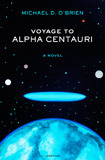 , continues to garner positive reviews. In a recently posted review, Dr. Mark Nowakowski writes:
, continues to garner positive reviews. In a recently posted review, Dr. Mark Nowakowski writes:
There is something indelibly graceful about reading the old masterworks of literature. Whereas many modern authors craft engaging stories that also serve as microcosms of their own existential angst and moral dysfunction, the old masters were often able to spin us a great yarn capable of ennobling our spirits while also providing potent lessons in history, philosophy and theology.
In our own times, Michael O’Brien has joined the small group of writers who have eschewed popular modernism in favor of writing rich, meaningful works concerned with the nature of things as they truly are.
Despite being rejected by major publishers early in his career for committing the seemingly cardinal offense of expressing an incarnational worldview in his writings, Michael O’Brien has found a home with Ignatius Press, a publisher whose small fiction catalog represents some of the most original new writing available today, building a worldwide following in the process.
With his most recent effort, “Voyage to Alpha Centauri,” O’Brien jumps genres into the realm of science fiction, continuing the long tradition of writing theologically meaningful sci-fi that was begun by authors such as C.S. Lewis. The comparison to Lewis is no exaggeration. In this recent volume, Michael O’Brien has penned an engaging and anthropocentric science fiction novel, one that moves beyond imaginary technology and implausible scenarios into a refreshingly human story.
Marvin Olasky, editor of World magazine, had this to say about O'Brien in a piece titled, "Stings like a bee":
Now I’ve read three of his older works—Father Elijah (1997), Sophia House (2005), and Plague Journal (2009)—along with a just-published new one, Voyage to Alpha Centauri, all put out by Ignatius Press. Reading these three allows me to say that O’Brien is up there with Walker Percy and Flannery O’Connor in the pantheon of fiction writers from Roman Catholic backgrounds, but his style is in some ways the opposite of the sly and humorous Percy, who floats like a butterfly; O’Brien stings like a bee, or maybe a sledgehammer. ... O’Brien’s new novel is a venture into science fiction centered on a 19-year trip aboard a sleek, huge spaceship, with the narrator learning of oppression in the heavens as on Earth. O’Brien skillfully portrays a clash of worldviews without end, amen, with big brothers watching and demanding lying conformity.
Jeff Minick of the Smoky Mountain News writes:
Like all of O’Brien’s novels, Voyage to Alpha Centauri is a hefty tome capable of serving as a doorstop or weapon, and like those other books, Voyage also carries with it a cargo of ideas. Topics ranging from God to marriage and the family, from genetics to physics, fill the book and will entertain and instruct the reader who enjoys philosophy in the guise of fiction. Because the other travelers are from all parts of the earth, O’Brien is free to look at other ideas and religions as well: the concept of freedom versus security, for example, or the contrasts between Eastern and Western thought. History and literature are also given heavy play in these conversations, so that the novel makes in many respects for mediation on the meaning of human personhood.
The esoteric parts of the story, however, never impede the story itself or diminish the many details regarding the Kosmos and its journey. O’Brien describes the ship so well, from its lounges and cabins to the working of its engines, that readers quickly come to see how much time and effort he put into his futuristic creation. Some of the gadgetry — the computers, the doors that open at the sound of a voice, the medical treatments — are not the stuff of Start Trek, but instead seem very real extensions of the electronics available today.
Like many other works of science fiction, Voyage to Alpha Centauri also contains a meditation and a warning on science itself.
Fr. Z. wrote, "I hope [O'Brien] writes in this genre again!":
It is interesting that O’Brien has moved into science fiction. He has written about quite a few different contexts, contemporary and historical, but this is new for him and he did a fine job of it. The technology plays a role in the thrust of the narrative, as if it were a character: an important character. Moreover, the work is deeply Catholic and theological, even though there is very little that is overtly Catholic in the first part. It is Catholic in its worldview rather than in its surface trappings.
You might call this book “theological sci-fi”.
O’Brien is deeply concerned about human freedom and our dignity as images of God. Thus, in his books he often explores the problems caused by the expanding and encroaching State and about the evil, truly diabolical evil, that lurks behind attacks on human dignity. He is also convinced that we need to have clear archetypes and symbols, that evil should be recognizable as evil and good as good.
Eric Thomason, writing for Catholic World Report, says:
O’Brien’s novels, then, are profoundly rooted in Scripture, which from its first pages warns man to turn from Satan’s folly—“you shall be as gods, knowing good and evil” (Gen.3:5)—and to embrace the way of Christ, who “humbled himself, becoming obedient unto death, even to the death of the cross” (Phil.2:7). O’Brien’s heroes and heroines are icons of Mary’s Magnificat: “He hath scattered the proud in the conceit of their heart. He hath put down the mighty from their seat and hath exalted the humble” (Luke 1:51-52). Like Mary, by remaining small, by remaining faithful, they are able to counter the “the spirits of wickedness in the high places” (Eph.6:12).
In a world awash in empty ambition, self-indulgent spirituality, and politically correct visions of renewal, O’Brien’s earthy, broken, and wonderfully human characters are a balm. His stories, too, are a wake-up call, reminding us to return to those things which comprise the truly good life: God, family, solidarity with the lowly, attentiveness to nature, and authentic art.
Like O’Brien’s other works, Alpha Centauri is lengthy, and therefore includes a variety of themes other than those mentioned here. Some of these which may resonate with various readers are reverence for creation, humility in the intellectual life, the holiness of the ordinary, the nature of art, and ecumenism.
The Catholicism Anew blog interviewed O'Brien about the novel:
Here you are a Catholic writer, a Catholic novelist, this I understand your first novel in Science Fiction, how you bring Catholicism and Science Fiction together?
My approach is different than most science fiction. Most contemporary science fiction focuses exclusively on technological wonders and tends to move more and more in the direction of pseudo mysticism combines with technological. There are a lot of preternational and supernatural elements in modern sci. fi I think it is because there is such a void in modern man who have not received, authentic spirituality and real thought. So He is very limited, he is very fragmented.
In my book, I tell a story of a 19 year voyage that is to our closest star, Alpha Centauri a round trip trip. A lot happens on this huge space ship that comes from Earth, there are six hundred people there are many dramas that take place during the outward bound voyage. Some of the people are Christians, clandestine Christians, mostly Catholic. Most are not. Because the world is set 100 years in the future, it has become very secularized, a kind of neo-totalitarian world where the state rules everything.
My faith comes through the characters displayed, their characters, their struggles, both believers and the non believers. I would say that the defining part of the story is about faith, really about the destiny of the Universe itself, has to do with redemption. As Christ redeemed the universe he is restoring to the Father in the long process over salvation history.
The 587 page novel is available in hardback and as an electronic book download.
January 30, 2014
Catholic Universities: Identity, Faith, and Power
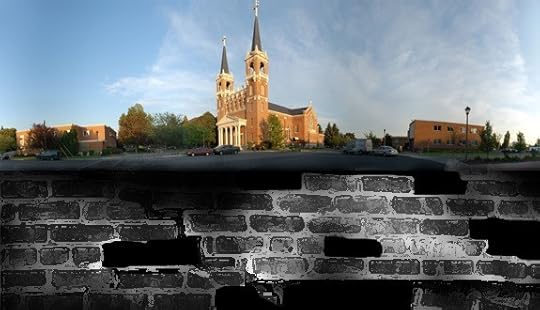
Catholic Universities: Identity, Faith, and Power | Dr. Eric Cunningham | CWR
We are fighting to preserve and recover the Catholic faith in our schools precisely because it has been replaced by “Catholic identity.”
In the 1960s and ’70s, the name Marshall McLuhan became a household word for the bourgeoisie of the western world, and something of a mantra for its intelligentsia. McLuhan’s ground-breaking and often prophetic insights into the transformative effects of mass media and technology upon human consciousness gave him a rare status among professional academics—not only was he a professor of English in the every-day world, but a rock star in the realm of pop culture. While my own research in literature and postmodern culture has brought me into contact with McLuhan’s work many times in the last 15 years, it was not until several years ago that I learned that McLuhan, in addition to being a counter-culture icon, was also a devout Catholic.
Recently, while web-surfing for information about McLuhan’s faith, I came across a brief video snippet from his 1977 talk show appearance with TV Ontario’s Mike McManus.
In this interview, McLuhan was offering some ideas on why separatism and sectarian violence were inevitable in a globalizing world. In response to McManus’ observation that global tribalism had not resulted in a more “friendly” world, McLuhan agreed, noting that, “when people get close together, they get more and more savagely impatient with each other.”
“The Global Village,” McLuhan observed, “is a place of very arduous interfaces and very abrasive situations.”
He added that these “abrasive situations” and incidents of “savage” impatience emerge because people feel a need to define and assert their identity in a world that increasingly and systematically forces them to trade their individuality for membership in a global tribe. “All forms of violence,” McLuhan asserted, “are a quest for identity.”
I have spent a great deal of time over the last few weeks pondering this provocative remark and considering its implications for the work of preserving Catholic culture on the campuses of Catholic universities. It was never my intention, when I began teaching at a Jesuit university, to take up arms in the great ecclesiological culture war, although I have been drawn into it as a combatant of sorts. It has been very disquieting at times because despite the satisfaction one inevitably gains from standing for one’s principles—and for one’s Church in an increasingly irreligious age—the end-game and the real stakes involved are never entirely clear.
My colleagues in this struggle would argue that the Catholic identity of our institutions is at stake, but even that is confusing, because the resident clerics and theologians who are the designated experts on things “Catholic” seem to be quite content with the general downward trend of Catholic representation on faculties, the downward trend of Catholic representation among the student bodies, the replacement of a theology departments with religious studies departments, the reduction of religious studies and philosophy classes in the core curricula, the radical decrease in Jesuit vocations, the replacement of an overtly religious community ethos with a secular ethos, etc., etc., etc.
Roman Rights and Wrongs
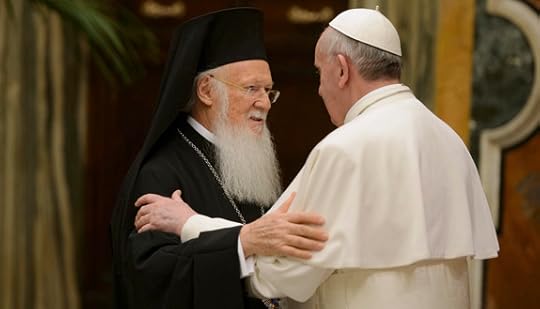
Pope Francis embraces Ecumenical Patriarch Bartholomew of Constantinople at the Vatican in March 2013. (CNS photo/L'Osservatore Romano via Reuters)
Roman Rights and Wrongs | Dr. Adam A. J. DeVille | CWR
What needs to change for East-West unity to happen?
Every January for over a century now, Christians have set aside a special week to pray for unity. This week, my friend the Orthodox priest and historian Oliver Herbel posted an excellent reflection in which he upbraided his fellow Orthodox for, as he powerfully put it, “spitting in the eye of Rome” every time she makes advances towards East-West unity. Father Oliver then went on to note some changes that he and his fellow Orthodox should make to respond better to Rome’s invitations.
Let me return the favor of my gracious friend. Speaking as an Eastern Catholic who tries to help East and West understand each other, let me offer a few reflections on the kind of changes Eastern Catholics and, perforce, Eastern Orthodox, want to see in very practical ways for unity to become a closer and more realistic possibility. However, I do not want to be thought querulous, so let me dwell briefly on areas where I think Roman practice is right and needs to be encouraged:
1) Ecclesial organization: Anyone who knows anything about Orthodoxy in North America knows that one of her besetting struggles is with ecclesial disorganization. Early ecclesiology rather strictly prescribed one bishop to one city to avoid the problems of overlapping and conflicting jurisdictions. Orthodoxy still upholds this as the ideal (as does Rome), but has long struggled with making it a reality in this country. Indeed, the most recent effort to overcome this problem—the so-called episcopal assembly of all Orthodox bishops—seems this month on the verge of collapse, which is sad but not surprising.
Rome, however, has in some ways been better able (though not perfectly so) to avoid these problems and to keep Catholics of all traditions—Eastern and Western—united in certain (imperfect) regional structures. For example, the United States Conference of Catholic Bishops (USCCB) includes Latin and Eastern bishops on full and equal terms and they regularly meet together in organized fashion twice a year, with Eastern Catholics also serving in the other committees of the USCCB. Though the USCCB (and comparable conferences around the world) are not the synods, they could and should be, as I have argued elsewhere, and they are at the very least a commendable start down that road.
2) Canonical updating:
January 29, 2014
New: "Who Is a Christian?" by Hans Urs von Balthasar
Now available from Ignatius Press:
Who Is a Christian?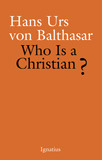
by Hans Urs von Balthasar
The title of this book is a short question. In its longer form, the question would be: "In the changed circumstances after the 2ndVatican Council-with its theme of aggiornamento or ‘updating', especially in the areas of the Bible, the Liturgy, Ecumenism, and openness to the modern world-what does it really mean to be a Christian today?"
Balthasar begins by acknowledging the confusion of many in the post-Conciliar period. He then describes the valuable contributions of the Council in those four areas. But he also describes their "shadows": what could go wrong and often did go wrong. Finally he points out the path to genuine renewal in the personal life of the Christian and in the Christian's service of the world.
Among the key topics and issues Balthasar discusses that are important for the authentic renewal of the Christian life include: The Primacy of Contemplation, Who Is a ‘‘Mature Christian''?, Love, The Form of the Christian Life, How Should a Christian Serve the World-and How Not?, Despite Everything, a Single Commitment , and Prayer, Hope, and the Profane.
"We must therefore resolve to turn around and approach what seemed to be behind us as something before us. To have the question before us, ‘Who is a Christian?', together with our effort to answer it, is the right approach, for the answer will necessarily come to us from the source from which our Christian life itself is given, namely, God's living Word . . . We rightly find God in the sign of Word and Sacrament, but only in order to seek him ever more passionately where he is not and where we must bring him. Or, rather where he already dwells unseen, and where we must discover him."
-Hans Urs von Balthasar
Hans Urs von Balthasar (1905-88), a Swiss theologian and priest, is considered by many the most important Catholic theologian of the twentieth century. Incredibly prolific and diverse, he wrote over one hundred books and many hundreds of articles. A favorite theologian and spiritual writer of Pope Francis, as well as the two previous Popes, he was called "the most cultured man of our time" by Henri de Lubac, and Karl Rahner described his achievements as "really breathtaking."
January 28, 2014
Free Speech and Politics in San Francisco

by Gibbons J. Cooney | CWR blog
Which banners actually “undermine public health”?
On December 26, the Walk for Life West Coast, working through the city’s Department of Public Works, had 50 banners placed on lampposts on San Francisco’s Market Street. The banners were in preparation for the January 25 Walk for Life West Coast, the second-largest pro-life event in the country and one of the largest annual events to be held in San Francisco. The banners met all requirements and proclaimed the Walk’s contention: “Abortion Hurts Women.” Not everyone was happy. On December 31, the San Francisco Chronicle reported that Ellen Shaffer of the Silver Ribbon Committee, a pro-abortion group, had demanded that Mayor Ed Lee have the banners removed. Mayor Lee’s spokesman Francis Tang responded “Mayor Lee is a staunch, longtime defender of a woman’s right to choose and disagrees strongly with the message of the banners, but the mayor’s disapproval obviously doesn’t and shouldn’t trump the First Amendment of the U.S. Constitution.”
Would that the San Francisco Board of Supervisors could understand such a simple principle of civic responsibility. On January 14, in the latest seemingly willful effort to make themselves ridiculous, Supervisor David Campos, joined by six of his colleagues, jumped on Ms. Shaffer’s bandwagon, and introduced a resolution opposing the banners. The Chronicle reporter covering the resolution expressed appropriate skepticism “While the resolution may have many San Franciscans nodding in agreement, it’s seems unlikely that city has any legal right to refuse to post something simply because politicians don’t like the message.”
The Supervisors resolution was reported nationwide. Even the San Francisco Chronicle–no friend of the Walk for Life West Coast–condemned the resolution in a January 24 editorial. Here’s an excerpt from the Chronicle’s op-ed:
Carl E. Olson's Blog
- Carl E. Olson's profile
- 20 followers


